
|  |

|  |
 e-mail: khokar1960@gmail.com Kathak Kumbha! (Part 2) Photos courtesy: Kathak Kendra April 17, 2025 Kathak Kumbha! (Part 1)  Kathak Kendra presented the 37th Mahotsava in Delhi from March 21-26. It was a mammoth gathering of scholars, academicians, dancers, gurus, students and audiences. Last year, it had undertaken one such in Pune, where many of the Pune gurus and stars could be platformed like guru Shama Bhate, who had just the year before also been bestowed the SNA honour and Rujuta Soman, who has done unique works and recently devised a sound footboard to keep rhythm while performing! It is a unique invention, since live musicians are so difficult to get both for reasons of cost and time. Next year if Kathak Kendra hosts in Bangalore or Hyderabad, actually there's more Kathak in Bangalore today than even Bombay if pure statistics, festivals and scholars and audience interest is to be seen. The 37th Kathak Mahotsava in Delhi continued its juggernaut with 3 speakers and a moderator in the morning session and 3 dancers in the evening. For Director of the Kathak Kendra to have got a variety of chief guests - babus and unknown vocalists who like on the first day came 90 minutes late - Invite such but don't wait, is the lesson. Natyashastra even tells what the quality of a sabhapati ought to be, but not many would qualify today!  Rahul Sharma with Dr.Puru Dadhich Day 3 of the Literary Festival (actually it should be called LITERATURE as they were each discussing and platforming their books, not LITERARY aspects of Kathak. Two totally different things. Who decided these terms?). Compered by Rahul Sharma, it set the tone with his polished diction and clear compering. Here is one male voice for stage that's both articulate in Hindi and English and humorous to cover up other's lapses on stage. Director of the Kendra, Pranamee Bhagwati thanked chief guest of the session Praveen Mishra and the three authors assembled: Dr. Vibha Dadhich, Dr. Mandavi Singh and Dr. Chetana Jyotishi Beohar, who was coming home after ages. She has served the Kathak Kendra as director 15 years ago and her term was much talked about even after her (like Mohan Khokar's in the 1970s, Keshav Kothari's in the 1980s and Jiwan Pani's in the 1990s) as then she was considered an outsider from the Hindi belt. It was the era of English types in coalition government and Hindi heartland talents rarely got prominent roles in Delhi scheme of things. How times have changed now. One sees many marginalised names now centre stage and in central or cultural institutions. Chief guest Praveen Kumar Mishra, a joint director ASI, invited all to research more and focus on temples. Patna chalo, seemed to be his tag line! Dr. Vibha Dadhich first reminded one of a smiling tai, aunty, one used to access and learn from. She simplified many Shastric concepts like shastra adhyan and prayog are two sides of the same coin. This was the first-ever such gathering by Kathak Kendra. Reference to Sumitra Charat Ram, who founded the Shriram Bharatiya Kala Kendra in 1947 were made as the Kathak Kendra itself was borne out of that. Dr. Vibha Dadhich maintained that Abhyas with Adhyay were the twin tracks, that's why shastric knowledge and art also blossomed. She shared how her parents focused on education. She was sent to Bhatkhande (then called Marris College, Lucknow). Her topic for M.A. was focused on "Bharatiya nritya ki varn mala" and how to "prayog karne ki vidhi 21 lakshanaprayog"... theory and practice were equally important then. She shared the importance of the last ruler of Awadh, Wajid Ali Shah, whose treatise Najjo and Banni are important source material for 21 gat nikas and bhav, including of animal gaits. She was homely and queenly in sharing knowledge. How our classical dance forms were deity driven: Shankar has many faces, one need not show only tandava all the time! Her student Harshita depicted the story of Trishul, created to destroy Tripurasura, whose boon from Brahma ensured no chance for annihilation unless all three centres/heads were killed at the same time. She did an able demo on Shankar. Prof. Dr. Mandavi Singh's reputation precedes her as a serious academic and she looked very serious all the time on stage. She elaborated on Shastra and prayog first time ever through her 3 books: first was in1990. Second edition 2010. Third, on the way in 2025. Reason was she said, "When I was starting out then, there was dearth of literature in Khairagarh university and thus with Natyashastra as base, I could develop more." She noted: "Mohan Khokar's books were so easy to read and access. That's the beauty of his writing." She remembered her mentor, "The Khairagarh university guide, P.A. Ashirwaadam, was exceptional and excellent as he knew South Indian and North languages. His motto was: STUDENTS NEED TO LEARN AND IMBIBE SHASTRAS." Raja Chakradhar Singh, the king of Raigarh, and Raja Birendra Bahadur Singh, king of Khairagarh, were both art lovers and the latter donated his palace to the cause of art and culture, which now is a famous university. Nothing new, as ten years earlier, the Maharaja of Baroda, Gaekwad had given half his kingdom to the cause of education. In fact, the famous MSU (Maharaja Sayaji Rao University) was born in 1949. Mohan Khokar was the founder head of the Dance Dept. It is still up and running in 2025 and the course he set then in 1950s is the standard course there and many other universities, with some modification. Dr. Chetana Jyotishi Beohar was a new, rather unknown name in Delhi when she took over as Director of the Kathak Kendra in 2010s. She was from the Hindi belt, then looked down upon in Delhi. Either you were a Delhite / Punjabi / refugee or you were rich / convent educated and English types! That was the trend then till ache din started in 2014. Today, the Hindi proficient have taken over many institutions but the Kathak Kendra director doesn’t know Hindi well enough to use on stage or officially in all protocols. That's very strange because one can't be Director of Kalakshetra or Kalamandalam without knowing Tamil, Malayalam or Sanskrit or one of the south Indian languages. Chetana was also one of the most literate and educated directors of the Kathak Kendra then. She is sabhya, sushil, sahrdayi and solid. Add, of a sweet disposition. An artiste has to be sweet inside to show good art outside. Heart has ART built in. Art must have a satvik he-art! She started with an ode to her gurus both in hall, on stage and in Vaikuntha like Premlata Sharma "Behenji," her Ph.D. guide. "She used to say how important shastric parampara is," so Behenji desired Chetana acquire knowledge first. Chetana shared that while all the 4 raj nartaks were in Raigarh, they were not formally educated. So, degree became important for jobs. She was the only one who remembered Ashok Vajpeyi, the IAS bureaucrat of Madhya Pradesh, who was active in cultural scene then and helped create Bharat Bhawan under Arjun Singh, the CM's patronage and also brought Raigarh centre stage. His patronage actually helped formalise the Raigarh gharana. Without Ashok Vajpeyi backing, Raigarh may perhaps not even be accepted as a gharana. When Chetana had a question on Draupadi and the pancha Pandavas, Premlata Behenji simply said: 'Do a Ph.D.' Gurus taught by simple guidance those days because they were real gurus. The 3rd evening performance began by chief guesting of a new director in the Culture Ministry, Priyanka. Ashok Tiwari of Sanskar Bharati spoke well that "Kala manushya ko manushya banata hein." Art makes humans human. Afsar Mulla Khan of Benaras gharana (His guru Ashiq Hussain Khan sahib looked like a film star and shifted to Lahore later, thereby creating what's Lahore gharana) had Satish on padhant, Yogesh Gangani who peetos (beats) the tabla; I was afraid the skin of his tablas would burst open! Mulla took Natraja stuti for a start, then Teen taal (16 beats, very popular in entire festival, many did this or Dhamar, the 14 beat cycle). He also claimed links to the Janaki Prasad gharana from father. Janaki Prasad gharana best specimens have been Pt. Hazarilal and his wife Sunaina. Afsar had lots of energy, almost like a youngster. He finished with an ode to Shivaji Maharaj with Kalash Varkari ending. Varkaris are minstrels of Maharashtra. Living there now, he is trying to merge and adapt with the local eco systems. Moumala Nayak was next. She undertook Jai jai Durga jivan hari - a song by Pt Bhimsen Joshi. She showed Parans of different types which had nice samm (endings). She concluded with gopis talk to Radha - Neer bharan kesse jaun - which was sung sweetly, although the harmonium interfered. Next, she undertook "chotti ki daggar" and reminisced: "Last when I performed this, it was my singer Zakir's birthday and today too!" Kanha ki bansi concluded her recital. Rani Khanam group was last that evening, offering an ode to Yamuna river that runs through Delhi. Music was stronger than the group, which had uneven quality and Kathak Kendra festival is a big platform. But Rani maintains clarity of choreography and good lines. Giving her 20 minutes is like going to a fine dine to eat french fries, not a 5 course meal. 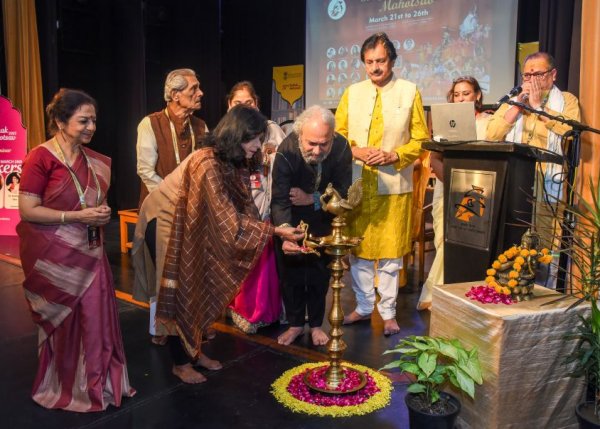 Raja of Rewa (in yellow) Day 4 morning session was a seminar on Kathak in which experts discussed various topics. On the starting day, (4th of 6 day festival) first was the contribution of royal courts to Kathak. The Director each day got an unusual chief guest and for this session there was the Raja of Rewa himself. As yours truly was the moderator so best to refrain from commenting on myself but the standing ovation in the end said it all. It was also the only interactive session for students to ask questions. Not much time was left in the end (late starts and Kathakaars getting a mike make for a bad combo!). The session was prasad coming from 3 divergent sources: 90 year old guru Ramlal Bareth, son of legendary Pt. Kartik Ram of Raigarh gharana; metro India's star dancer and officer Shovana Narayan and a radio-voiced, lass of Lucknow whose beauty matched her brains - Kumkum Dhar. I felt and must have looked like wild life surrounded by kings and queens of dance in the forest of Chattisgarh! Kumkum Dhar read from a paper which can be boring but she made it interesting by breaking into a dialogue with the audience. Shovana Narayan has a gift of the gab now matched with practical field work in her native Bihar and in retirement from civil services, she is also using time to do research and books. Veteran guru Ramlal Bareth had the license of no brakes because coming all the way from Bilaspur, he needed to be heard. Daily attendee veteran Manjushree Chatterjee also wanted to recite her bols so she took to the mike from the wings. It was a race against time and my concerns were young India. They were not interested in talk but practical steps to help their growth and careers. Youngster Manpreet Singh of Jalandhar did make a valid point on how to succeed in dance field; alas, due to paucity of time, it could not be tackled in depth. The Raja of Rewa, royal looking to boot, was epitome of grace and culture and in his introduction itself shared how Rajwadas believed in goodness of their subjects, hence art was important, not mere entertainment to be promoted. Sonali Sharma as compere was both dulcet and intense. That evening the stage shifted from Kathak Kendra backyard to a spiffy Kamani Hall, where guru Prerna Shrimali, a senior Kathak dancer who has come a long way by hard work and focus on goodness in art, shone like a finely cut diamond. She is Guru Kundanlal Gangani's most senior shishya active today (Guru Urmila Nagar is there too, though hardly seen professionally much in recent years) other than his son and successor Rajendra Gangani, star of the style. Prerna based her rendition of Basant on Haveli Sangeet with usual Radha and the yonder moon, Teen taal next and Thumri thaat in ati vilambit that suited her age and knees. Her uthaan never bored and she shared a bandish which she enunciated as limit to limitless. It suited her to showcase slow and steady dance with meed - paran and baaju - bandh gat. Her musicians were her asset. 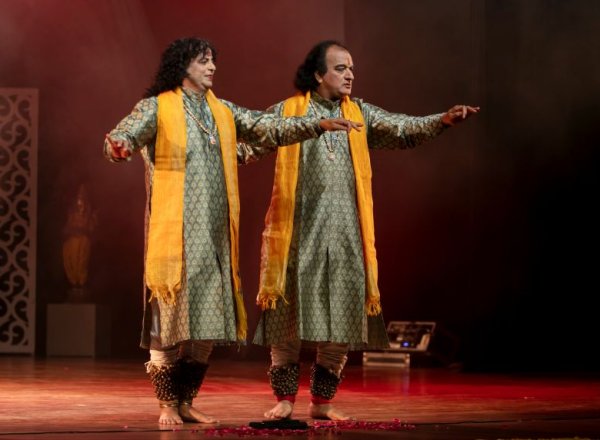 Mata Prasad and Ravi Shankar Mishra Benaras bandhu, Mata Prasad and Ravi Shankar Mishra next were like going back in time. The makeup of the younger one was unaesthetic and reminded one of a village nautanki. This kind of Kathak maybe a novelty in village fair but in metro India? Teental was well undertaken with tabla by their nephew Uday Shankar of Benaras, Santosh Mishra on vocals. They shared a dadra of guru Alaknanda (Sitara Devi was one of three sisters - Tara, Sitara, Alaknanda, daughters of Sukhdev Maharaj. Tara's son was Gopi Krishna, the "filmy" dancer). They concluded with Kanhiya ji morre te kesa jaadu dala... The standing ovation they got showed Kathak has lobbies / favourites. 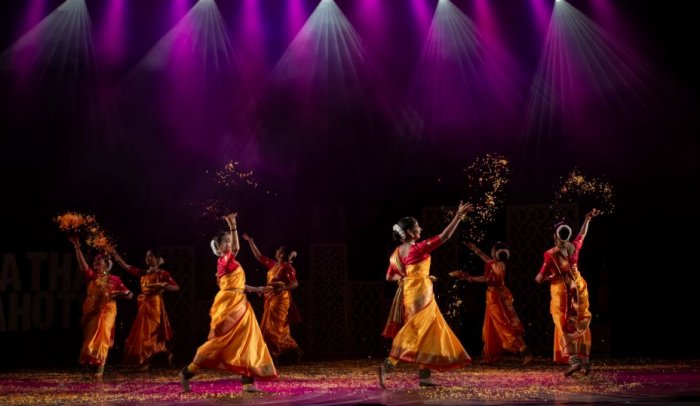 Puru Dadhich's ensemble  Puru & Vibha Dadhich Puru Dadhich is now the Bhishma Pitamaha of Sanskritised Kathak scene in the Hindi heartland - Madhya Pradesh, Indore to be precise. Coming on stage was more like a reference point. Sweet chumban (kiss) on a 70 year old Vibha Dadhich looked cute! What was happy making was seeing well turned out, uniform dancers who looked the pretty polly kids in orange costumes, representing belated basant ... The 75 minute production coming third in an evening of delayed start again showed how tight editing could help make this a total artistic experience of brevity. Beauty was there, in abundance. On day 5 morning, Delhi's active library talent (ex JNU, current head of Kalanidhi section and dean admin of IGNCA) Dr. Ramesh Chandra Gaur referred to the importance of archiving and need to digitise. He is knowledgeable about processes and vastly informed too of variety of lateral subjects like NEP, in which he said there's the story telling component and pointed what better than Kathak? Dr. Poornima Pande as the first speaker was from Marris College (now Bhatkhande) and started with a parmelu - vilambit parmelu demo by her shishya Vallari. Dr. Pande's discourse stated that "at first there were no gharanas, then there were both." Here's a real scholar, pedantic to boot and she summed up saying: There was detail and variety (vistaar and vivadhta). Doyenne of dance Kumudini Lakhia's sanitised Kathak was talked of but when requested senior artiste Kumkum Dhar, sitting in front row was reluctant to show a chalan, a gift of legend Lachchu Maharaj. Doyen Shambhu Maharaj's kaun gali gayon Shyam was showcased with rose smell, cremation, combing act all part of it. Dr. Poornima Pande then talked of academician-musician guru Mohan Rao Kallianpurkar's command of layakari. Bandishes were then of very high quality. He'd give matra and say go make yourself Vistaar ta thai tai tar...The highlight of Birju Maharaj clips on two friends - sust and chust - lazy and active, was seen and all enjoyed his mastery, how he brought in everyday life into highly stylised classical dance. 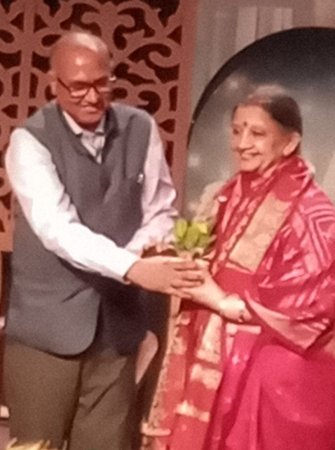 Dr. Ramesh Chandra Gaur felicitates Nandini Singh Delhi's most gracious and truly cultured Kathak artiste Nandini Singh started her discourse by saying, "I will speak the truth and from my experience. Under the courts dance had become an entertainment". She shared filtered knowledge that, "There was elaboration on one bol. Bol meant bandish too. Ocean has both pebbles and pearls. All vilambit were aamad. Aamad was not separate. Bandish when ends in stop to stand is thaat. Samm: Even eye could not flicker." Also platformed was Anubhav: ek hi paran. She gave anecdotal information that the legendary singer Naina Devi (Nina Ripjit Singh, a lineage to princess of Kapurthala) kept her name as Nandini, else it was Nimmi. Kathak Mahotsava threw up such vignettes. Like, "In Uthaan, we would not have regular sangat (accompanists), so we managed with whosoever we got." Ghungat types of ehsaas / experience she depicted on stage impromptu, how to bring andar ke bhaav bahar (inside feelings out). She maintained padhant should have bhaav. Parmelu comprising of full varnmala was de rigeur. It was an academic start to finish. Mandavi Singh next was no nonsense, no extra talk like most Kathakaars do. She is an academician first and last and her discourse established that. She stated: 'Raigarh is not a formal gharana but started by one Raja Chakradhar who ruled from 1924-1947.' Her reading the paper was like a lived class room experience. Filtered knowledge is best when it reaches the audiences, especially young India. Their attention span is 90 seconds (that's why Insta is tailored to that time frame after clinical research). Moderator Kanchan Bhardwaj did well with a smile in place. 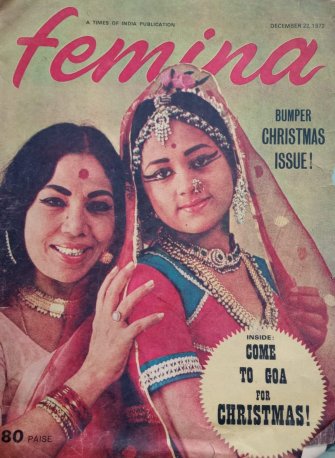 Femina cover of Sitara Devi and daughter Jayantimala (courtesy: MKDC @ignca) Jayantimala's discourse was on early history of how her ancestors came up in Benaras Kabir Choraha. Of things in British India, where even a cop had right to see if art was cheap or classy! She used clips from films to show how good Sitara Devi and Gopi Krishna danced. Both looked filmy! Her discourse was fast, often conjecture with no brakes. Like mother like daughter. I remember Sitara Devi coming home for dinner on her Delhi visits and she preferred liquid diet to solid! She was full of stories, warmth and bindas attitude to a life in art. My mother would heat food many times as her stories went on and on and we kids got sleepy. She went on and on like Duracell batteries! She was an original. God never made anyone like her. Day 5 evening at Kamani started late again and in rushed a high velocity Bhopal Express! It was one high-powered, oops, powdered dancer from Bhopal - V. Anuradha Singh. She had no repose, theraav in her dance. She threw powder on stage to undertake chakkar and routine fare. A student of Birju Maharaj, she showcased Chakradhar Kathak Centre material too. She was a riot of colours in a garish red blue costume and zig zag alta that was unique. Her whole personality was geared to get eyeballs. Her rendition in 9.5 matra with Salim Allahwale on vocal and tabla (two in one!) was spiffy. The two-in-one had loads of attitude. Long hair is now part of aharya for most tabla players. Her Shiva Stuti too was a rather filmy depiction with too much lokadharmi aspect. Chalan next, sharp but unsettled. Crane catching fish looked more like a dhobi ghat. Hiran ka shikar was regressive and in that, hiran (deer) was missing! Madhumita Misra Roy and Paromita Moitra were like a gol mol Rosogollo pair. Sweet but limited. Too loud a tabla and pakhawaj but Ashish Gangani was good and so were vocals by Deepanshu and sitar by Salim Kumar. Their fare never rose above the ordinary. Teen taal - throughout the 6 day festival - was a must do. In hand and feet of ordinary talents, what was left to be seen? Whoever curated this festival had no clue to Kathak or items, what suited the flow of days and progression. The last group of Bipul Chandra Das was equally bland with student level girls and two male dancers whose postures were not correct. Still for novelty sake, it was more like Sankeertana Kathak!! Shankar dev krit hori with Bhaskar Ojha on the tabla and Rahul Das on sitar played well. In the end, there were less than 50 people left in the Kamani hall, half of which were Kathak Kendra staff. Last day morning session, Jt. Sect. Arvind Kumar coming from ASI background, talked of how at Partition of India the so called Mohenjo-Daro dancing doll came to India in division of artefacts and the 'bearded man' went to Pakistan. That was an over simplification of history. Punjabis have lost a country, a land, all their wealth and relatives and soul. Ditto Bengal. Moderator "Parichay Das" Ravindra Nath Shrivastava was an able handler of the proceedings where Prof. Ranjana Srivastava, ex dean BHU, proved to be the most benign person in the whole 6 day Kathak Mahotsava. What a genial personality. She proved this is what art does. Make humans really refined. If, if, if, no ego is involved. Where art is bigger than the artiste: MS Subbulakshmi, D.K. Pattammal, Mrinalini Sarabhai, M.K. Saroja, Birju Maharaj - their face and lives say it all. Benign. Our arts demand sincerity and honesty. Her discourse was that nothing is perfect; that's why our dance requires practice. Kathak nritya is only under 100 years old, she explained. It is more music. Bindadin family were all great musicians first. "We have been SIMPLIFYING Kathak for decades" she said categorically. Best part is INTER RELATIONSHIP and INTER DEPENDANCE. Nartak was there always, she felt only theory got left behind, or its articulation. This festival brought the theory and history part to fore, that's its biggest achievement. Kathak folks were treated poorly when India became independent. The first two decades (1950 -1970) went in establishing traditional gurus without work as courts had fallen and patronage shifted from courts to Delhi sarkar, the new rajas. Then next two decades (1970s -1990s) went in popularising the form through new works and dance dramas. 1990 - 2010 was its international outreach and diaspora dance. Last 25 years have gone in giving it an academic bent and theoretical base by those who could not really become professional dancers or by those really interested in academics. In today's age, Google is guru, and with AI coming, future of the form will be for all to see. Dr. Parul Purohit of World Design University next was best in the morning session with her power point presentation. She talked of Chhand but also included modern new poets, Agyeya, Sitakant Mohapatra...she shared that, "We are no more focussing on importance of words." Then she asked: why is research important? Why do we need to go to the past? It brings pride. Research teaches humility, tolerance and respect. Kathak she felt was a dance of classes that has become dance of the masses. Chitra Sharma was a mixed bag with work on YouTube and youth outreach and going beyond gharanas. She then went back to 3 main gharanas, and Raigarh, talking of roots… All in all, coming on last of 6 days, last session it was a case of ennui. The concluding day at Kamani was chief guested by BJP idealogue Vinay Shahsrabudhe, ex President of ICCR and Amita Sarabhai, major domo of ministry of culture who gave hope when she said we must give young India a chance to dance. 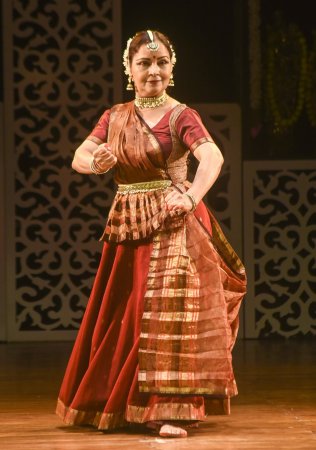 Malti Shyam Last day was reserved for stars of Kathak, guru Malti Shyam, whose Shiv stotram showed total control. It was a stable Shiva, not tottering! High aesthetics and her decades of being a professional showed in breathing - when a dancer can deliver with mouth closed, it means tayari, tehzeeb and total oneness. That Kathak folks can keep their mouth shut is itself a big achievement! Malti is sorted, sensible and stable. She thanked two pillars, her guru Birju Maharaj and Kathak Kendra, with all past directors and staff. No one had done that in past 6 days! Her teen taal was refreshing and clearly enunciated. Her parans had the feel of a swing, she enjoys what she does. Birju Maharaj tihai was like scissors criss cross. In Gat nikas, the snake slide was bewitching. Aman Ali on tabla, Salma Khan on pakhawaj, flute by Dhiraj and padhant by Yanika Mahesh were apt. Even the musicians were in sync, not trying to show off or each asking for volume of their instrument to be increased which is a bane of live musicians these days. 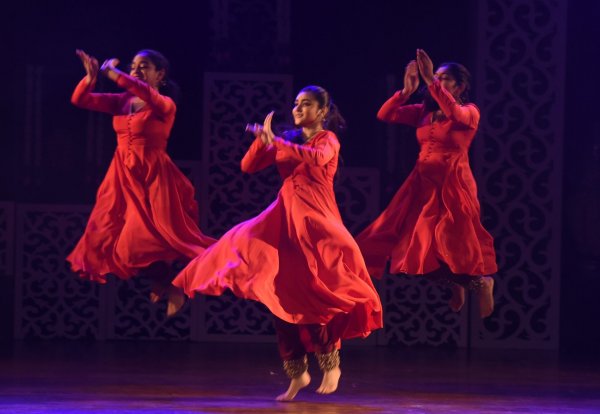 Kadamb ensemble Kumudini Lakhia's group Kadamb under charge of youngsters like Rupanshi Thakkar showed her spiffy work Atah Kim, done many decades ago. Sharp, swift, magical even in drab grey toned costumes that in second half ushered in red, proved to be an anomaly actually in seven days of traditional Kathak fare. 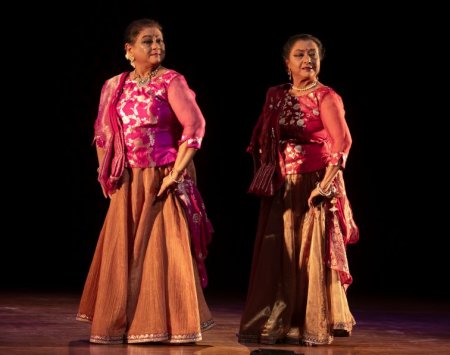 Vaswati Mishra and Saswati Sen Sisters Saswati Sen and Vaswati Mishra have benefitted most by being with Birju Maharaj, the longest. Vaswati stated she felt like Eklavya who learnt by inference from afar but in her case her thumb was intact! She shared her Dronacharya was a master of maths and showcased some gems. Gat bhav, Ashtanayikas was her mainstay. Saswati Sen next brought in laya paksh / Basant in 9 and a half matra. She has an infectious personality on stage, almost like a girl child one saw 40 years ago on stage in kho kho match created for DD Taal Mel Dance serial in1995 or film Shatranj Ke Khiladi done in 1975! The two sisters proved the enduring charm is Kathak and the standing ovation said it all. As the curtains came down on this momentous mahotsav, one felt an era was coming to an end. What the future brings, time alone will tell. 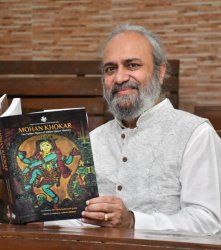 Critic, connoisseur, historian, author, artivist, archivist, administrator and more - editor, columnist and mentor Ashish Khokar remains true to his muse. More on attendance-india.com Responses * The festival organised by Kathak Kendra was very enriching for the domain of performing arts. It included performances, deliberations and discussions on books. It was a rare opportunity when artists and academicians from all over the nation had gathered at one platform. Ashish ji was part of all the events. The Kathak Kendra festival has been well covered by him. People have high hopes from him and his writings are significant for documentation of such unique events. - Prof. Mandavi Singh, Lucknow (April 22, 2025) * A comprehensive and exhaustive coverage. While reading it I felt as if I had attended the whole festival. The coverage has a visual quality to it. What is encouraging to see is that it is not just a straightforward report but an analysis. For any art form to grow constructively, it is so important to have critical and thought provoking views. The views can be open to discussion and debate but that is what is required. - Rachana Yadav (April 22, 2025) * What a detailed and engaging review! I am impressed with the minute observations along with feedback simultaneously. It makes the review more like an interesting story. One can truly visualize the entire mega Kathak Mahotsav through your words, Ashish ji. It feels as if we are experiencing the festival all over again just by reading it. Once again kudos to entire Kathak Kendra teamwork under the able guidance of director Pranamee ji. - Shila Mehta, Mumbai (April 22, 2025) * I am hosting these kinds of events since 2015 but I haven't read such fantastic coverage or deep analysis of our cultural traditions, art forms and so on. So I want to thank & congratulate Ashish Sir for bringing this piece of written art work. - Rahul Sharma (April 18, 2025) Post your comments Please provide your name and email id when you use the Anonymous/blog profile to post a comment. All appropriate comments posted with name and email id in the blog will also be featured in the site. |